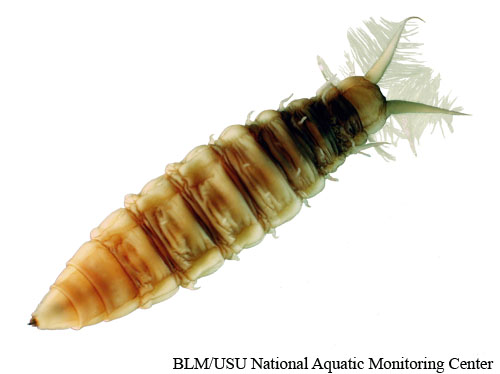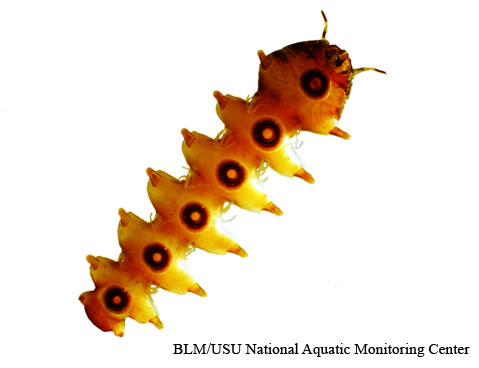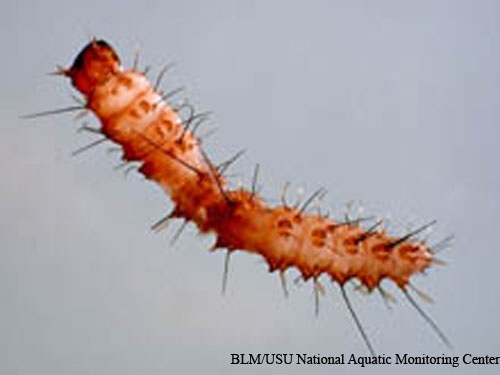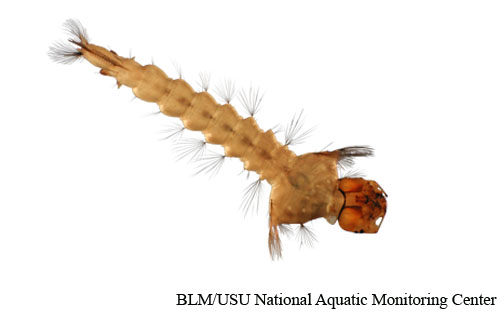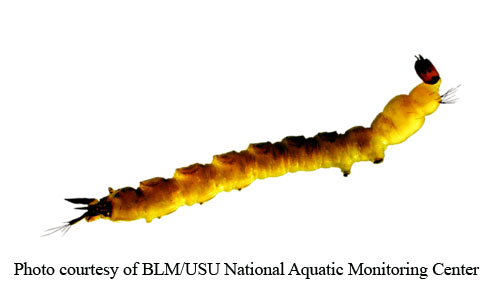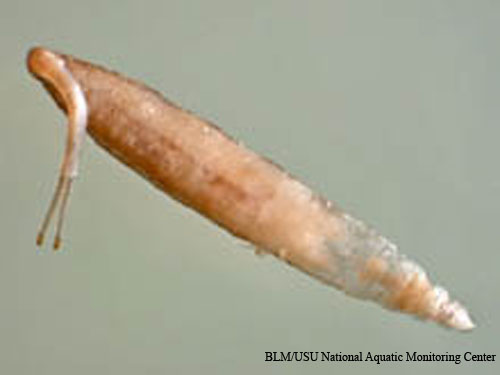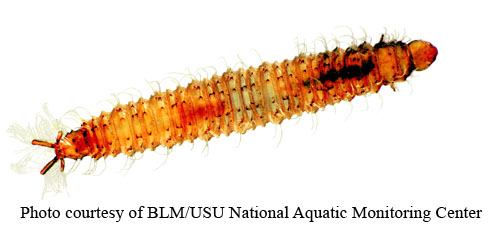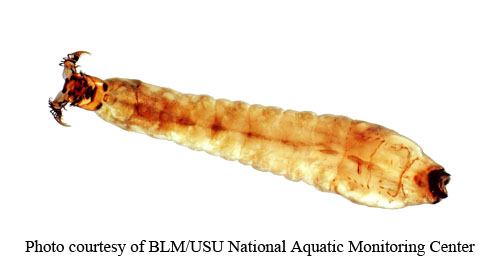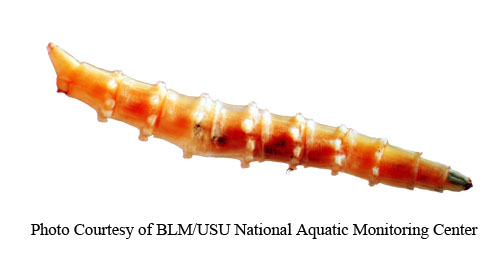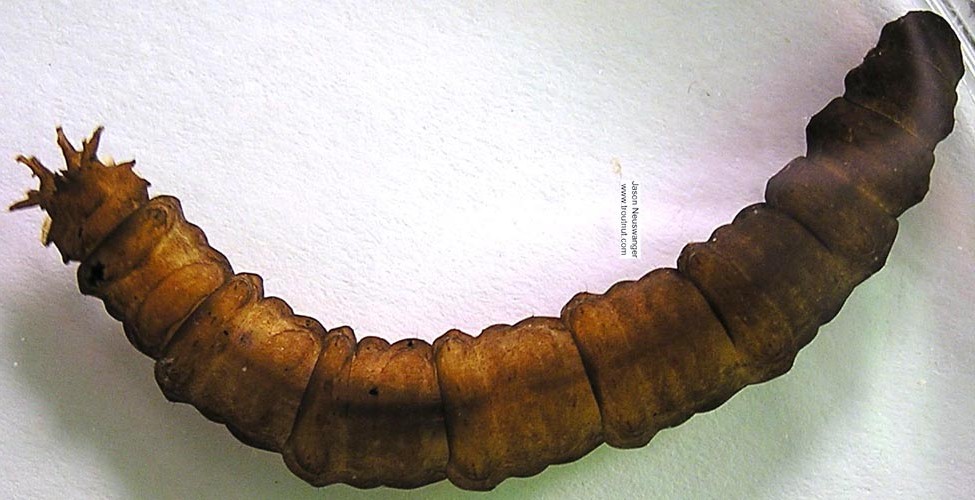UPCOMING EVENTS
View full calendarKey to Aquatic Macroinvertebrates in Utah - Diptera
Worm-like organisms with tentacles, brushes or tails typically belong to the order Diptera, or true flies.
There are over 22 families of true flies found in Utah. All organisms shown here are in the larva stage.
Family
Athericidae (Watersnipe Fly)
Description: Athericidae have several (typically 7) pairs of well-developed ventral pro-legs, dorsal and lateral filaments on each segment, and a pair of divergent processes on the posterior end. 2-20 mm in length.
Habitat: Rapid moving freshwater, common in erosional areas in rivers and streams throughout North America.
Blephariceridae (Net-winged midge)
Description: Blephariceridae have 7 distinct segments with a ventral sucker on each of the first 6 segments. 4-12 mm in length.Photo is a ventral view.
Habitat: Upper surface of rocks in fast moving water, occurs in mountainous regions throughout North America.
Ceratopogonidae (Biting midge, Buffalo gnat)
More ImagesChaoboridae (Phantom midge)
Description: Chaoboridae have clear to transparent bodies. The head is separated from their thorax. 8-15 mm in length.
Habitat: Large lakes to small ponds, throughout North America in still fresh water.
Chironomidae (Midge)
Description: Chironomidae have thoracic and terminal prolegs. They are slender with slightly curved bodies and a well defined head capsule. 2-20 mm in length.
Habitat: Still and fast moving water, wetlands, temporary and permanent wetted habitats throughout North America.
Culicidae (Mosquitoes)
Deuterophlebiidae (Mountain Midge)
Description: Deuterophlebiidae larvae have flattened bodies, sucker-like lobes on 7 pairs of prolegs, and forked antennae longer than head. 3-10 mm in length.
Habitat: Fast moving fresh water in mountainous streams throughout western North America.
Dixidae (Dixid midge)
Description: Dixidae are elongate and slender with 3 thoracic segments. The abdomen terminates in a breathing tube and lateral paddle-like structures. 3-7 mm in length.
Habitat: Fast and still fresh water, throughout North America in a variety of aquatic habitats.
Dolichopodidae (Aquatic long-legged fly)
Description: Dolichopodidae abdomens terminate in a concave pit surrounded by short projecting lobes. Abdomen with or without prolegs. 3-10 mm in length.
Habitat: Mostly still water, occur throughout North America.
Empididae (Dance Fly)
Description: Empididae may have 7-8 prolegs. The anterior end of the abdomen ends in a cone shaped point. 2-7 mm in length.
Habitat: Fast moving water, occur in variety of aquatic habitats throughout North America.
Ephydridae (Shore Fly, Brine Fly)
Description: Ephydridae have wrinkled and extendable body, with or without prolegs. 2-12 mm in length.
Habitat: Still or slow moving water. Ephydridae can withstand hard conditions, including high salinity, temperatures and pollution.
Muscidae (Muscid)
Description: Muscidae have welt like prolegs and have 2 short breathing tubes. 6-14 mm in length.
Habitat: Fast moving and still water, occur in various aquatic habitats throughout North America.
Psychodidae (Moth Fly)
Description: Psychodidae lack prolegs, abdominal segments are subdivided, a short hardened breathing tube at the terminal end of abdomen. Less than 5 mm in length.
Habitat: Fast moving and still fresh water, occur in clean to highly polluted waters throughout North America.
Ptychoperidae (Phantom Cranefly)
Description: Ptychoperidae have extendable bodies and long extendable breathing tube. Prolegs are present on first 3 abdominal segments. 15-60 mm in length.
Habitat: Still fresh water, occur in ponds and wetlands throughout North America.
Sciomyzidae (Marsh Fly)
Description: Sciomyzidae have elongated, cylindrical body with a pointed anterior end. Posterior end is surrounded by several short lobes and may have a breathing tube. 5-15 mm in length.
Habitat: Still water, occur in wetlands, marsh habitats throughout North America (not common).
Simuliidae (Black Fly)
Description: Larvae are cylindrical with a bulbous distal abdomen, distinct fan-like brushes occur on the sides of their head. 3-12 mm in length.
Habitat: Flowing water, occur in running water habitats throughout North America.
Stratiomyidae (Soldier Fly)
Description: Stratiomyidae has a leathery feel and appearance due to calcium deposits. Head extends from thorax. No prolegs. 5-30 mm in length.
Habitat: Fast moving and some still fresh water, occurs throughout North America along aquatic habitat margins.
Syrphidae (Rattail maggot, Flower Fly)
Description: Syrphidae larvae are soft-bodied, semi-transparent, and wrinkled. They breath through a long breathing tube on the posterior end. Some species have ventral prolegs. 5-25 mm in length.
Habitat: Still waters, tree holes, bogs, occur throughout North America.
Tabanidae (Deer Fly, Horse Fly)
Description: Larvae are elongate, cylindrical and tapers to a pointed cone at both ends, there are no breathing tubes at the posterior end of their abdomen. 10-50 mm in length.
Habitat: Fast moving and still fresh water, common throughout North America.
Tanyderidae (Primitive Crane Fly)
Description: Larvae are slender and elongate, six long spine-like filaments that extend from the posterior end of their abdomen. 10-20 mm in length.
Habitat: Fast moving fresh water, occurs throughout North America.
Tipulidae (Crane Fly)
Description: Larvae have elongated cylindrical shape, head capsule is retracted into their thorax, abdomen terminates in 2 spiracles that are surrounded by short fleshy lobes. 10-100 mm in length.
Habitat: Fast moving and still fresh water, occur in depositional habitats throughout North America.

